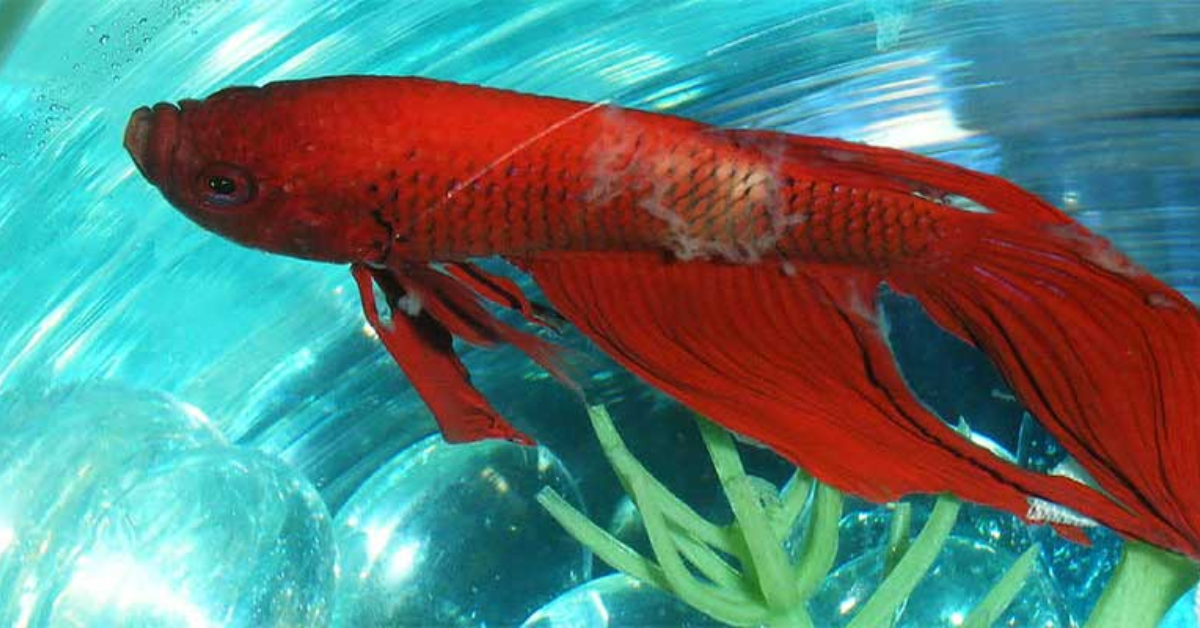Betta fish, known for their vibrant colors and flowing fins, are beloved pets worldwide. However, like any pet, they are susceptible to various diseases, which can affect their health and appearance. Recognizing the symptoms early and providing timely treatment can make all the difference in the health of your betta fish. This guide will cover common betta fish diseases, their causes, symptoms, and available treatments, complete with images to help you identify each condition.
1. Fin Rot
- Cause: Fin rot is often due to poor water conditions or bacterial infections. Stress and injuries can also make bettas more susceptible.
- Symptoms: Fraying or discoloration of the fins, with edges turning black, white, or red. Fins may appear torn or ragged.
- Treatment: Clean water is crucial. Use antibacterial medication specifically formulated for fin rot and improve water quality by regular changes.
2. Ich (White Spot Disease)
- Cause: Caused by a parasite called Ichthyophthirius multifiliis which thrives in poor water quality.
- Symptoms: Tiny white spots resembling grains of salt appear on the betta’s body and fins. Fish may rub against objects to relieve itching.
- Treatment: Raise the water temperature gradually (within safe limits) to accelerate the parasite’s life cycle. Use over-the-counter ich medications and ensure the tank is well-aerated.
3. Velvet Disease
- Cause: Velvet is caused by a parasite (Piscinoodinium).
- Symptoms: A golden or rust-colored dust appears on the fish’s body, often visible under a flashlight. Other symptoms include lethargy and clamped fins.
- Treatment: Quarantine the infected fish. Use aquarium salt and copper-based medications as prescribed. Keep the tank dark as light may enhance the parasite’s activity.
4. Swim Bladder Disorder
- Cause: Overfeeding or poor-quality food can disrupt the swim bladder, causing bloating or buoyancy issues.
- Symptoms: Betta may struggle to swim upright, float at the surface, or sink to the bottom of the tank.
- Treatment: Fast the fish for 24-48 hours, then offer fiber-rich foods like a shelled pea. Avoid overfeeding to prevent future issues.
5. Columnaris (Cotton Wool Disease)
- Cause: A bacterial infection caused by Flavobacterium columnare, usually triggered by poor water conditions.
- Symptoms: Cotton-like growths on the mouth, gills, and fins. Lesions may appear on the body, and the betta may display labored breathing.
- Treatment: Quarantine and treat with antibiotics formulated for aquarium use. Maintain pristine water quality to prevent recurrence.
6. Dropsy
- Cause: Often a result of internal bacterial infection affecting the kidney function.
- Symptoms: Swelling of the abdomen, scales that stand out (pinecone appearance), and lethargy.
- Treatment: Dropsy is difficult to treat but can sometimes be managed with antibiotics and aquarium salt. Clean water and a healthy diet can prevent it.
7. Gill Hyperplasia
- Cause: Poor water conditions, especially high ammonia levels.
- Symptoms: Swollen or enlarged gills, labored breathing, and spending more time at the water’s surface.
- Treatment: Improve water quality immediately. Use products that neutralize ammonia and maintain regular water changes.
Tips for Preventing Betta Fish Diseases
- Maintain Optimal Water Quality: Regular water changes and a proper filtration system are essential for keeping harmful bacteria at bay.
- Avoid Overfeeding: Feed bettas a balanced diet and avoid overfeeding, which can lead to constipation and water contamination.
- Monitor Water Temperature: Bettas thrive in temperatures between 76°F and 82°F (24°C-28°C). Use a heater to maintain consistent temperatures.
- Quarantine New Fish: Always quarantine new fish before adding them to the main tank to prevent the introduction of diseases.
